Increased Efficiency and Resolution with Kinetex„ Core-Shell Technology
Over the past several years column manufacturers have been introducing columns packed with smaller particle sizes – sub-2 µm and 3 µm – to take advantage of the improvements that such small particle size columns offer.
Philip Koerner and Terrell Mathews, Phenomenex, Inc.
Over the past several years column manufacturers have been introducing columns packed with smaller particle sizes – sub-2 µm and 3 µm – to take advantage of the improvements that such small particle size columns offer. The benefits offered by these columns include faster separations (see Technical Note TN-1057) due to the reduction in the resistance to mass transfer term (C-term) in the van Deemter equation (Graph 1) allowing for higher efficiency over a wider range of linear velocity.
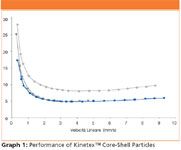
Graph 1
As known, from the familiar resolution equation (below), an increase in column efficiency directly results in an increase in resolution that is equal to the square root of the increase in efficiency.
k = the average value for the two peaks
a = the measurement of the spacing between the two peaks, expressed as: a = k2/k1
A comparison of the efficiency of Kinetex™ column across multiple instrument platforms was performed. In addition, other small fully porous particle columns were compared as a reference against the performance observed for Kinetex™ core-shell technology.
Results and Discussion
Part 1: Increased Efficiency
Fast LC on Traditional HPLC System
The first examples (Figures 1a & 1b) focus on how Kinetex™ 2.6 µm compares with a high efficiency 3 µm material in a commonly used analytical column dimension (150 X 4.6 mm) on a traditional HPLC system (Agilent 1100). One can observe that the column efficiency, as tested by injecting a standard reversed phase column test mixture, for Kinetex™ column is dramatically increased versus a Luna® 3 µm C18(2) column. The Kinetex™ column exhibits column efficiencies greater than 225,000 plates/meter (p/m) – more than 60 % greater than the high efficiency Luna® 3 µm 150 X 4.6 mm column under the same isocratic mobile phase conditions. The peaks are significantly narrower and the analysis time much shorter on the Kinetex™ column, indicating that the expected benefits provided by smaller particle size HPLC columns (higher efficiency, faster separations, and improved resolution) can be obtained even when using older model HPLC systems.
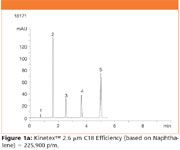
Figure 1a
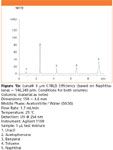
Figure 1b
Fast LC on Agilent 1200 SL RRLC System
The next example (Figures 2a & 2b) looks at how Kinetex™ columns compare with other materials packed in a commonly used "fast LC" column dimension (50 X 4.6 mm) on a Rapid Resolution HPLC system (Agilent 1200SL) that has a higher pressure limit (600 bar) and significantly reduced dead volume as compared to the more widely available traditional HPLC systems having 400 bar pressure limits. The Kinetex™ core-shell media provides notably higher column efficiencies than the fully porous Agilent Technologies ZORBAX® 1.8 µm media, despite a larger particle size (2.6 µm vs. 1.8 µm). This illustrates the significant benefits provided by the shorter diffusion path for the superficially porous Kinetex™ media on the C-term in the van Deemter equation, and ultimately on the overall column efficiency. Kinetex™ delivers superior column efficiencies in a shorter analysis time with significantly narrower and taller peaks, which also result in an increase in sensitivity.
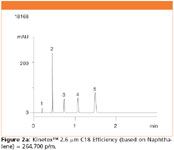
Figure 2a

Figure 2b
Fast LC on Waters® AcQuity® UPLC® System
In this example, (Figures 3a & 3b) a comparison of the performance of Kinetex™ 1.7 µm C18 with the Waters® ACQUITY® BEH 1.7 µm C18 as tested on the Waters® ACQUITY® UPLC® system. The Waters® UPLC® system was specifically designed for operation at high pressures, allowing for the use of sub-2 µm particles packed into short, narrow ID columns to obtain very fast separations while maintaining chromatographic resolution. The chromatograms show that the Kinetex™ 1.7 µm column provides a significantly higher column efficiency than the Waters® Acquity® 1.7 µm column (>318,000 p/m vs. >272,080 p/m) under the same isocratic conditions for the column test mixture. Once again, this highlights the benefits of the shorter diffusion path associated with the Kinetex™ core-shell technology, which result in a significant improvement in column efficiency, peak shape, and overall analysis time.
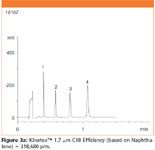
Figure 3a
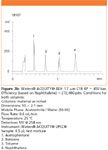
Figure 3b
Part 2: Increased Resolution
Increased Column Efficiencies Using a Traditional HPLC System
The following examples (Figures 4a & 4b) show how the increased efficiency of Kinetex™ columns leads to improved resolution of closely eluted analytes. The first example shows the effect of increased column efficiencies using Kinetex™ on a standard HPLC system (Agilent 1100) for the isocratic separation of Aflatoxins. This separation can be performed with good resolution of all four aflatoxins (G2, B2, G1, and B1) on a Luna® 3 µm C18(2) 150 X 4.6 mm column (Figure 4b) in about 8 min. The critical pair, B2 and G1, is baseline resolved with resolution (Rs) = 1.98. Substituting Kinetex™ 2.6 µm C18 150 X 4.6 mm for the Luna® column, on the same system, and maintaining the mobile phase composition and flow rate, one can see (Figure 4a) the increase in efficiency (142,240 to 227,233 plates/meter) obtained with the Kinetex™ column results in an increase in resolution from 1.98 to 2.46.

Figure 4a
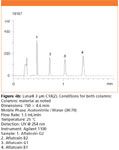
Figure 4b
Increased Column Efficiencies on Waters® ACQUITY® UPLC® System
A final example shows the improvement on resolution and peak capacity using Kinetex™ provides on a high pressure capable LC system (Waters® ACQUITY® UPLC®). The separation of the sulfa drugs can be performed with baseline resolution of all four analytes in less than 1.5 min on a Waters® ACQUITY® BEH 1.7 µm C18 50 X 2.1 mm column (Figure 5b). The measured average peak capacity is 137. The critical pair sulfathiazole and sulfamerazine are baseline resolved with Rs = 3.52. Under the same conditions with the Kinetex™ 1.7 µm C18 50 X 2.1 mm (Figure 5a), the separation is also baseline resolved in less than 1.5 min. However, the higher efficiency provided by the Kinetex ™ 1.7 µm column results in an increased average peak capacity (148 vs. 137) and an increase in resolution from 3.52 to 3.97.

Figure 5a

Figure 5b
In this case there is only a marginal improvement in sample throughput, as both columns provide the desired separation of the four analytes in about the same time. The real benefit is in the incremental improvement in resolution provided by Kinetex™ 1.7 µm particle because of the higher efficiency and average peak capacity.
Conclusion
The examples provided in this technical note illustrate the significant benefits offered by the shorter diffusion path and uniform particle size of the Kinetex™ core-shell media. Kinetex™ columns result in significantly higher column efficiencies than traditional fully porous 3 µm and sub-2 µm columns in different dimensions (4.6 and 2.1 mm ID) and across different HPLC and UHPLC system platforms. This increase in column efficiencies provided by the Kinetex™ technology results in sharper, narrower peaks, and a significant increase in chromatographic resolution.

Phenomenex, Inc.
411 Madrid Ave., Torrance, CA 90501
tel. (310)212-0555, (310)328-7768
Website: www.phenomenex.com
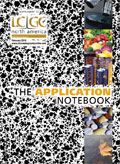
A Guide to (U)HPLC Column Selection for Protein Analysis
April 16th 2025Analytical scientists are faced with the task of finding the right column from an almost unmanageable range of products. This paper focuses on columns that enable protein analysis under native conditions through size exclusion, hydrophobic interaction, and ion exchange chromatography. It will highlight the different column characteristics—pore size, particle size, base matrices, column dimensions, ligands—and which questions will help decide which columns to use.
The Benefits of Custom Bonded Silica
April 1st 2025Not all chromatography resins are created equal. Off-the-shelf chromatography resins might not always meet the rigorous purification requirements of biopharmaceutical manufacturing. Custom bonded silica from Grace can address a wide range of separation challenges, leading to real performance improvements. Discover more about the latest innovations in chromatography silica from Grace, including VYDAC® and DAVISIL®.
5 Things to Consider When Selecting a Chromatography Silica
April 1st 2025Particularly in the pharmaceutical industry, drug purity isn’t just a goal – it’s essential for achieving safety, stability and efficacy. However, purification is easier said than done, especially with challenging molecules like DNA and RNA “oligonucleotides,” due in large part to their diversity and the range of impurities that can be generated during production. Enter DAVISIL® chromatographic silica, with a wide range of pore diameters and particle sizes to meet your specific application, performance and sustainability requirements. Before you choose the chromatography resin for your next purification application, take a look at these 5 considerations.
Automating Protein Purification: Efficiency, Yield, and Reproducibility
March 27th 2025Recent advancements in automated protein purification stress the importance of efficiency, scalability, and yield consistency. This eBook compares different purification platforms, highlighting their impact on downstream applications and demonstrating how automation enhances throughput and process control.















